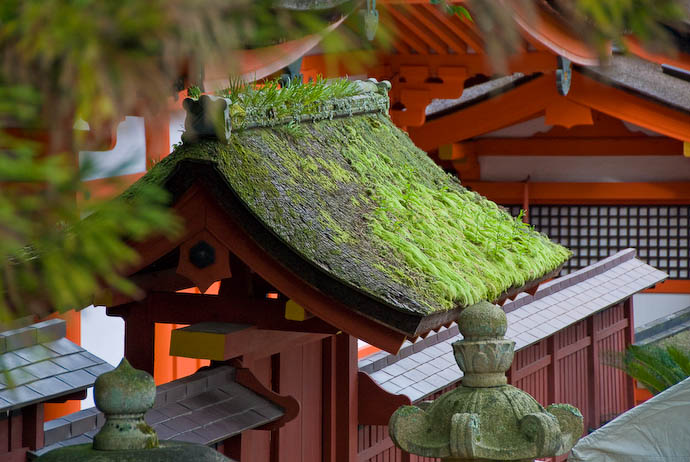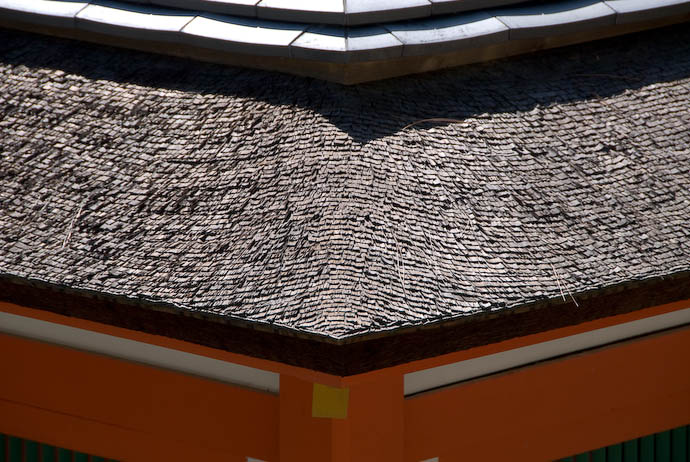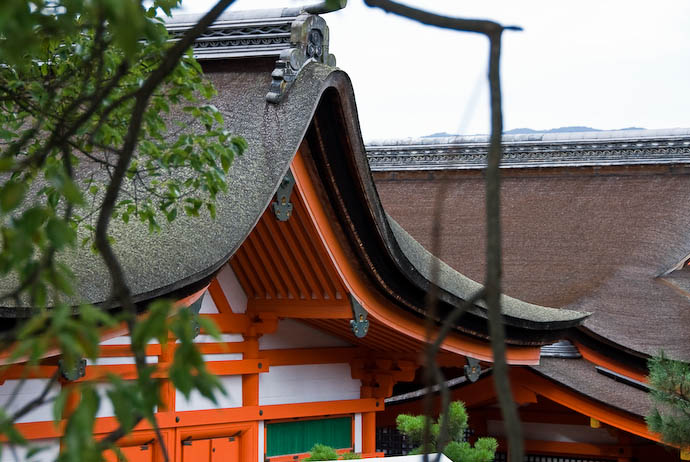
Nikon D200 + Nikkor 18-200mm f/3.5-5.6 VR @ 135 mm — 1/250 sec, f/5.6, ISO 320 — map & image data — nearby photos
Roof In Need of a Trim
At the Itsukushima Shrine (厳島神社、宮島), Miyajima Japan
I've mentioned recently how much I love the natural roofs of many temples and shrines, having noted it in recent posts about the Fushimi Inari Shrine and about the Kiyomizu Temple. The roof above, like the roofs cited in those posts, are made of many layers of thin sheets of what I assume is wood. Such a roof, over time, slowly breaks down and returns to nature.
Here's a relatively new one, as evidenced by the sharp shadows showing that the individual sheets of wood are still easily distinguishable as, well, individual sheets of wood....

Nikon D200 + Nikkor 18-200mm f/3.5-5.6 VR @ 170 mm — 1/500 sec, f/7.1, ISO 250 — map & image data — nearby photos
New Construction
( relatively speaking )
It's not so new that they're not all warped and curled – viewing the larger version shows that they're in pretty bad shape – but compare them with older roofs that time and the elements have made smooth and curvy...

Nikon D200 + Nikkor 18-200mm f/3.5-5.6 VR @ 65 mm — 1/320 sec, f/5, ISO 320 — map & image data — nearby photos
These pictures are from our trip to the Itsukushima Shrine on Miyajima Island (near Hiroshima) last year to see Kousuke Atari in Concert. The shrine is most well known for its main gate located in an intertidal zone, but it's quite pretty in its own right. The “nearby photos” link under any of the photos yields other photos I've posted from that trip.
The most common type of temple/shrine roof construction seems to be tile (such as this, this, and this), followed by the “layered thin sheet” style highlighted in today's post. Thatched-reed roofs seem to be less common, but not rare, such as here, here, and here.
I’m not sure what you mean by “thin strips of wood.” Are they like shake shingles, like you had on your California house, but maybe smaller?
Shingles are slabs of wood… these are really thin… maybe 1/16th or 1/8th of an inch… —Jeffy
I agree, the weathering is most attractive, though here moss on any roof is thought to be detrimental (since it eventually breaks down the surface and destroys the waterproofing) so zinc or copper is often used to destroy it. I also LOVE moss on stone or cement structures, which can be encouraged with a little yogurt or buttermilk along with the necessary moisture.
I’m not sure why, but that first photo really REALLY looks like a miniature villiage for some reason. I can’t get any real perspective, and to me it looks like a toy train should be chugging around those buildings 🙂
“The shingles are always split, and are very thin – being the thickness of an ordinary octavo book cover… There are other methods of shingling, in which the courses of shingles are laid very closely together, and also in many layers. Remarkable examples of this method may be seen in some of the temple roofs, and particularly the roofs of certain temple gateways in Kioto, where layers of the thinnest shingles, forming a mass a foot or more in thickness, are compactly laid, with the many graceful contours of the roof delicately preserved. … On seeing one of these roofs, one is reminded of a thatched roof, which this style seems evidently intended to imitate.”
– from page 81-82 of the 1961 Dover Press reprint of ‘Japanese Homes and their Surroundings’, by Edward S. Morse (originally published 1885), which I think I mentioned previously – a fascinating book!
Wow! Great note, Peter. Dover Books does have so many wonderful reprints of fascinating and out-of print books. So neat that you have that particular one. And I agree with Marci…that DOES look like a miniature structure, especially if that is actually grass growing from the roof peak.